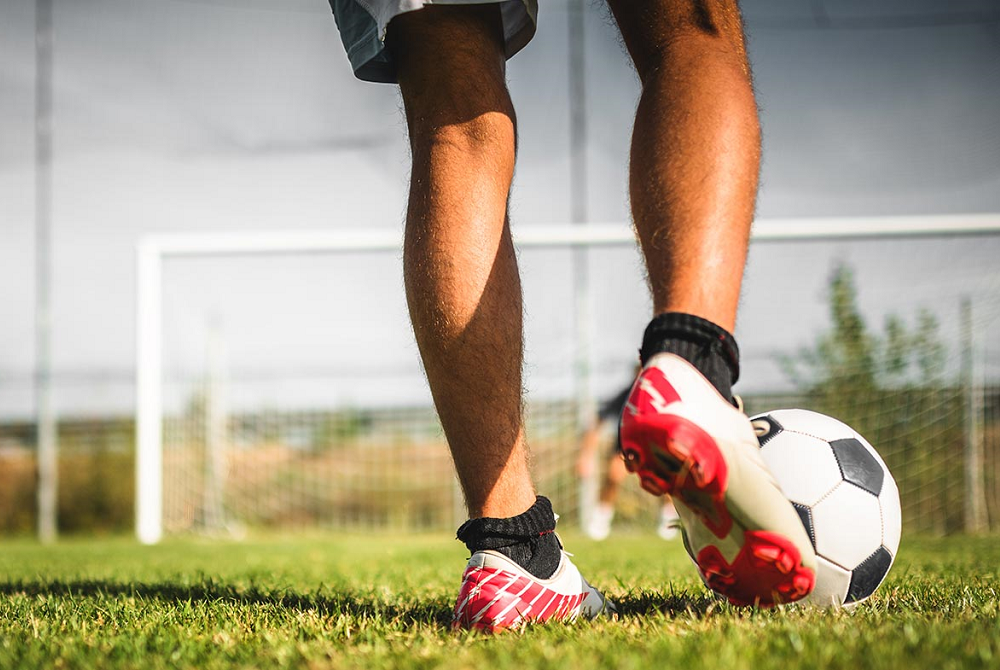
5 Ways Acupuncture Can Enhance Athletic Performance
May 9, 2023
In the ancient Chinese medicine of acupuncture, thin needles are gently inserted into specific areas of the body, stimulating blood flow to speed the recovery of certain ailments.
 It can be used as a treatment for everything from headaches and unbalanced hormones to joint pain and weakened immune systems. Acupuncture is also popular among athletes, as many of them incorporate it into their wellness regimens to stay in peak physical condition.
It can be used as a treatment for everything from headaches and unbalanced hormones to joint pain and weakened immune systems. Acupuncture is also popular among athletes, as many of them incorporate it into their wellness regimens to stay in peak physical condition.
“Back in the day, athletes ate steak, smoked cigars and drank whiskey during the week and then played football on Sunday,” says Thomas Betts, a sports medicine acupuncturist with Henry Ford Health System. “But today, to improve their performance, athletes are attacking the body from every angle possible with diet, lifestyle and exercise. NBA players, for example, have talked about how acupuncture keeps them feeling their best.”
But you don’t have to be an NBA star to reap the benefits of acupuncture. Whether you’re a professional or student athlete, or you exercise and play sports for fun or to challenge yourself, here are ways acupuncture can boost your game:
- Acupuncture can help you recover more quickly from an injury. “If a muscle is torn, acupuncture won’t put it back together, but for sprains and strains, muscle soreness and tendonitis, acupuncture can decrease inflammation and speed the healing process,” says Betts.
- Acupuncture can reduce the need for “rest days.” If you just had an intense workout and your muscles are sore, getting acupuncture afterward can loosen the muscles and decrease soreness so you don’t have to take a day off to recuperate before training again.
- Acupuncture can improve flexibility, decrease muscle tension and increase muscle activation. “This is done with motor point acupuncture,” says Betts. “The motor point is where the brain attaches to the muscle via the motor nerve. By using needles to stimulate a motor point, it is like rebooting a phone or computer that isn’t working well: Motor point acupuncture is autoregulating, in that it can deactivate a tight muscle or reactivate an inhibited or weak muscle.”
- Acupuncture can provide immediate pain relief. “Some studies show that acupuncture can provide as much as, if not more pain relief than medication,” Betts says. “It differs for everyone, and it depends on what is being treated, but some people say they feel a difference right after a session, and others say they feel better about 20 to 30 minutes later.” Pain relief can last from a few hours to a few days.
- Acupuncture can help prevent injury. Because acupuncture can reactivate weak muscles and decrease muscle tension, it can also be used as a preventative measure against injury, Betts says. But you should always still stretch before and after exercising!
Learn more about acupuncture and other integrative medicine services at Henry Ford. To make an appointment, you can request one online or by calling 1-833-246-4347.
Thomas Betts, DOAM, RAc, is a certified sports acupuncturist with Henry Ford Health. He sees patients at the Henry Ford Center for Athletic Medicine in Detroit.

How Exercise Can Help Reduce Your Anxiety
January 6, 2022
Stress and anxiety at any level can be hard to manage. If you’re searching for relief, try turning to exercise. Even the smallest amount of physical activity can make a significant difference and reduce stress.
“Anxiety affects our minds and bodies. Exercise can serve as a natural antidepressant, boosting our mood at the same time it improves our health,” said Megan LaDrigue, ATC CSCS, an athletic trainer at Henry Ford Health System. “You don’t need to join a gym to exercise. The world is full of opportunities to be more active. You can add in short exercise sessions throughout the day to recharge your mood and energy.”
How Anxiety Impacts Your Health
If not addressed, anxiety can impact your mental and physical health. “Anxiety causes an imbalance in the chemicals and hormones that support our brain, immune system, digestive health and sleep,” said LaDrigue.
Chronic stress can lower our feel-good hormones – serotonin, dopamine and epinephrine. At the same time, the stress hormone cortisol increases when we’re under pressure or anxious. As a result of these shifts, you may experience:
► Trouble concentrating and loss of productivity at work or school
► Irritability and moodiness
► Difficulty sleeping
► Weight gain and digestive problems
► High blood pressure and increased risk for other diseases
How Exercise Can Break The Stress Cycle
“By adding exercise into your daily routine, you can begin to manage anxiety and improve your overall health,” said Ladrigue. Exercise offers many benefits, including:
► Shifting your focus: Focusing on your physical activity is a chance to take a mental break from daily tasks and recharge.
► Improving mood and confidence: When you exercise, your heart contracts more frequently, increasing blood flow to the brain and triggering changes in those feel-good chemicals. These changes improve mood and confidence. Over time, exercise can also help build resilience by increasing your ability to tolerate stress.
► Enhancing concentration and productivity: Exercise activates the areas in the brain that control how we think and act. For example, physical activity can improve your ability to plan, organize and monitor behavior and tasks.
► Improving sleep: Fatigue can increase feelings of stress and anxiety, which increase your risk for insomnia or poor sleep. Exercise improves your ability to get the quality, restorative sleep that you need to recharge your mind and body.
3 Steps To Starting An Anxiety-Fighting Exercise Routine
The U.S. Department of Health and Human Services recommends adults get 150 minutes of moderate exercise per week. “But you don’t need to do all of that exercise at once. If you’re just getting started, gradually build exercise into your daily routine to create a healthy habit,” LaDrigue said.
Ladrigue recommends these three steps to build an anxiety-busting fitness routine:
- Make it fun: Whether it’s walking or weightlifting, if exercise doesn’t inspire you and make you feel good, it won’t help you manage anxiety. If being social helps motivate you, find a workout buddy and encourage each other to keep moving. Explore new types of exercise by taking an online or in-person fitness class.
- Create a flexible schedule: If finding time in your day to exercise adds to your stress, try working in shorter activity periods. Do some stretches while you’re waiting for the coffee to brew. Take a walk during lunch or while you’re talking on the phone. Use the stairs instead of the elevator. Park your car farther away from your destination and walk the extra distance.
- Set goals: Start by setting short-term goals for your fitness routine. Record your progress to stay focused and motivated. As exercise becomes a daily habit, set longer-term goals. For example, try a community walk or run, join a hiking club or participate in a local sports league.
Build An Effective Workout Plan
If you’re new to exercise or have an underlying health condition, check with your primary care physician before starting a fitness routine. Had an injury in the past? See a physical therapist or sports medicine provider to avoid future injuries.
If you’ve taken a break from exercise or are exercising for the first time, start slowly. Over time, you can gradually increase the time and intensity of your workout to meet your goals.
When picking an exercise program, Ladrigue suggests including these elements:
► Warm up: Start with five minutes of activity like jumping jacks or running in place to increase the blood flow to your muscles.
► Dynamic stretching: Gently move through small or large ranges of motion to elongate the muscle tissue. For example, you can try arm circles or walking quad stretches to get your muscles warmed up.
► Strength training: If you’re new to strength training, start with light weights. You can start with three sets of 10 repetitions for each muscle group. Combine sets for a muscle group on the front of the body immediately followed with a set for a muscle group on the back of the body, like biceps and triceps. This approach is called “super-setting.” It keeps your heart rate elevated while giving the working muscle group time to recover. It also increases your metabolic burn, the rate at which you burn calories during exercise.
► Aerobic activity: Choose from a variety of activities, like walking, running, biking, swimming or dancing. Light- to moderate-intensity exercise can help you recover at the end of a strength training workout while increasing oxygen and blood flow to the working tissues.
► Cool down: Hold stretches for 20 to 30 seconds to elongate the muscle tissue used in your workout. This type of stretching helps prevent or minimize soreness.
“While starting a new habit like exercise can seem daunting, stay positive. Feel empowered – you’re taking steps that will improve your overall mental and physical health for years to come,” said LaDrigue.
To find a primary care or sports medicine specialist at Henry Ford, visit henryford.com or call 1-800-436-7936.
Megan LaDrigue is an athletic trainer who works with the Henry Ford Sports Medicine Sports Performance Program.


